Personal finance education has gained significant traction in recent years, with many states now mandating it as a requirement for high school graduation. This development has been hailed by activists who have long advocated for greater emphasis on financial literacy.
According to a tracker maintained by Next Gen Personal Finance, the availability of standalone personal finance courses for high school students was limited to just eight states in 2020. However, this year marks a significant increase, with 25 states offering financial literacy classes in K-12. Of these, eight states have fully implemented the course, while 17 are still in the process of doing so.
Jessica Pelletier, the executive director of FitMoney, noted the sudden surge in state initiatives towards financial education, stating, “All of a sudden, it does seem like states are sitting up and taking notice, and it’s really just happened in the past couple of years.”
Experts emphasize that these classes go beyond basic financial tasks like writing checks. Despite the challenges posed by the COVID-19 pandemic, there is optimism that financial literacy education will continue to expand, potentially reaching students in middle school as well.
The pandemic appears to have heightened awareness about the importance of financial literacy among educators and parents. Pelletier suggested that the economic downturn and financial hardships experienced by many households during the pandemic contributed to a sense of urgency around financial education.
Lindsay Torrico, the executive director of the American Bankers Association (ABA) Foundation, highlighted the increased efforts to promote financial education. She stated, “Last year, we launched a new effort in a new commitment to engage more banks in financial education.”
Laura Levine, president and CEO of Jump$tart Coalition for Personal Financial Literacy, observed a steady growth in financial literacy education in schools over the past two decades. She emphasized that economic instability, such as the 2008 recession and the 2020 pandemic, often catalyzes interest in financial education.
The curriculum for financial literacy covers various topics, including earning income, spending, saving, investing, managing credit, and managing risk. Levine emphasized the comprehensive nature of the curriculum, stating, “We’re seeing if you look at the standard, it covers investing, insurance, savings, spending, budgeting, you know, it’s kind of a full spectrum.”
Recognizing the limitations of relying solely on financial education at home, many schools are now integrating financial literacy into their curriculum. Levine pointed out that not all students have access to financial education at home, particularly those from disadvantaged backgrounds or in foster care.
Efforts to promote financial literacy are not limited to high school education; there is also a growing emphasis on starting financial education at an earlier age. The ABA Foundation, for example, has programs targeting kindergarten through eighth grade, where bankers deliver presentations and lessons directly to students.
Kelsey Havemann, senior manager of the ABA Foundation’s youth financial education program, highlighted the community-driven initiatives to promote financial literacy, stating, “So the communities have taken it upon themselves to really step up and help out as much as they can with having bankers go into these classrooms and get these kids on the path to financial understanding.”
Despite the legislative progress, the push for greater financial literacy largely hinges on convincing adults to prioritize the subject. Pelletier noted that students are generally eager to learn about financial matters, recognizing the practical relevance of the knowledge they gain. She stated, “This is one of the only classes I’ve really heard of that almost every single student wants to take.”
The widespread adoption of personal finance education in schools reflects a growing recognition of the importance of financial literacy. While legislative efforts have played a role, community-driven initiatives and grassroots activism are also driving progress in this field. As financial education becomes more comprehensive and accessible, there is hope that future generations will be better equipped to navigate the complexities of personal finance.


